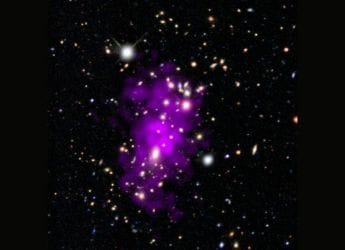- Home
- Science
- Science News
- Earth's Formation Explained With the Help of New Theory Using Laboratory Experiments, Computer Simulations
Earth's Formation Explained With the Help of New Theory Using Laboratory Experiments, Computer Simulations
Earlier theories on Earth's formation proposed that collisions of objects generated extreme heat left the planet in its current composition.

Photo Credit: ETH Zurich
Isotopes of an element have same number of protons but different number of neutrons
Digging deeper through laboratory experiments and computer simulations, researchers at the Eidgenossische Technische Hochschule (ETH) Zurich have proposed a new theory on the formation of the Earth. In their study, researchers developed models to demonstrate how planets formed in our solar system and shed light on their composition.
“The prevailing theory in astrophysics and cosmochemistry is that the Earth formed from chondritic asteroids. These are relatively small, simple blocks of rock and metal that formed early on in the solar system,” said Paolo Sossi, Professor of Experimental Planetology at ETH Zurich and lead author of the study published in Nature Astronomy.
Highlighting the lapses in the theory, Sossi said none of the mixtures of any chondrites can explain the exact composition of the Earth.
Some have earlier proposed that collisions of objects, which resulted in the formation of the Earth, generated extreme heat due to which lighter elements vapourised and left the planet in its current composition.
But, according to Sossi, these theories don't seem credible when one analyses the isotopic composition of our planet. The lead author underlined that isotopes of an element have the same number of protons but a different number of neutrons. Technically, isotopes with fewer neutrons are lighter and thus, should escape first. And, going by the heat vaporisation theory, there should be less number of light isotopes on Earth today, but this isn't the case.
To get a clearer picture, the researchers created dynamic models and simulated the formation of planets. Sossi said that small grains grew gradually by accumulating more and more material through gravitational pull and became kilometre-sized planetesimals.
Planetesimals and chondrites are both small bodies of rock and metal, but planetesimals have received more heat that helps differentiate between its metallic core and rocky mantle. In addition, the planetesimals that are formed in different areas around the [Sun](https://www.gadgets360.com/tags/sun) and at different times can differ in composition, Sossi elucidated.
Researchers ran simulations and collided thousands of planetesimals with each other in the early solar system. They observed that a mixture of several different planetesimals could lead to Earth's composition.
Now, researchers believe that they have a better model to explain the formation of the Earth and a reference to shed light on the formation of other rocky planets.
Catch the latest from the Consumer Electronics Show on Gadgets 360, at our CES 2026 hub.
Related Stories
- Samsung Galaxy Unpacked 2025
- ChatGPT
- Redmi Note 14 Pro+
- iPhone 16
- Apple Vision Pro
- Oneplus 12
- OnePlus Nord CE 3 Lite 5G
- iPhone 13
- Xiaomi 14 Pro
- Oppo Find N3
- Tecno Spark Go (2023)
- Realme V30
- Best Phones Under 25000
- Samsung Galaxy S24 Series
- Cryptocurrency
- iQoo 12
- Samsung Galaxy S24 Ultra
- Giottus
- Samsung Galaxy Z Flip 5
- Apple 'Scary Fast'
- Housefull 5
- GoPro Hero 12 Black Review
- Invincible Season 2
- JioGlass
- HD Ready TV
- Laptop Under 50000
- Smartwatch Under 10000
- Latest Mobile Phones
- Compare Phones
- OPPO Reno 15 Pro Max
- Honor Win RT
- Honor Win
- Xiaomi 17 Ultra Leica Edition
- Xiaomi 17 Ultra
- Huawei Nova 15
- Huawei Nova 15 Pro
- Huawei Nova 15 Ultra
- Asus ProArt P16
- MacBook Pro 14-inch (M5, 2025)
- OPPO Pad Air 5
- Huawei MatePad 11.5 (2026)
- Xiaomi Watch 5
- Huawei Watch 10th Anniversary Edition
- Acerpure Nitro Z Series 100-inch QLED TV
- Samsung 43 Inch LED Ultra HD (4K) Smart TV (UA43UE81AFULXL)
- Asus ROG Ally
- Nintendo Switch Lite
- Haier 1.6 Ton 5 Star Inverter Split AC (HSU19G-MZAID5BN-INV)
- Haier 1.6 Ton 5 Star Inverter Split AC (HSU19G-MZAIM5BN-INV)

















